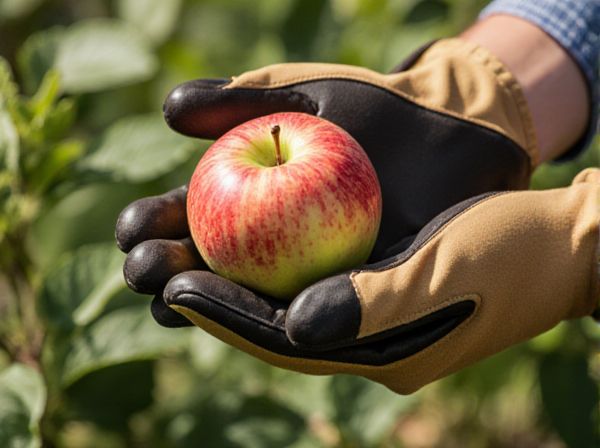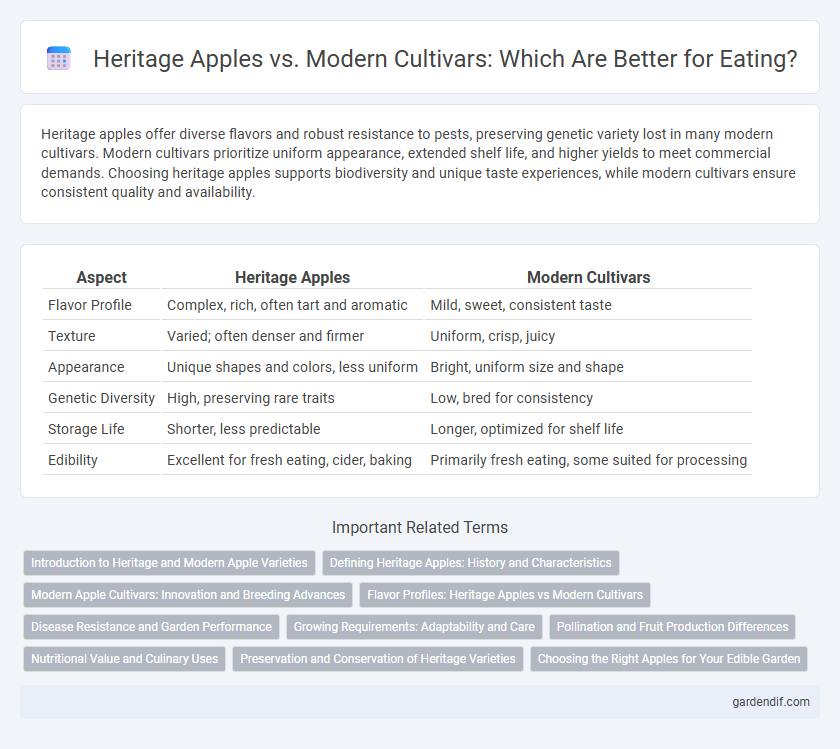
Heritage Apples vs Modern Cultivars Illustration
Heritage apples offer diverse flavors and robust resistance to pests, preserving genetic variety lost in many modern cultivars. Modern cultivars prioritize uniform appearance, extended shelf life, and higher yields to meet commercial demands. Choosing heritage apples supports biodiversity and unique taste experiences, while modern cultivars ensure consistent quality and availability.
Table of Comparison
| Aspect | Heritage Apples | Modern Cultivars |
|---|---|---|
| Flavor Profile | Complex, rich, often tart and aromatic | Mild, sweet, consistent taste |
| Texture | Varied; often denser and firmer | Uniform, crisp, juicy |
| Appearance | Unique shapes and colors, less uniform | Bright, uniform size and shape |
| Genetic Diversity | High, preserving rare traits | Low, bred for consistency |
| Storage Life | Shorter, less predictable | Longer, optimized for shelf life |
| Edibility | Excellent for fresh eating, cider, baking | Primarily fresh eating, some suited for processing |
Introduction to Heritage and Modern Apple Varieties
Heritage apples refer to traditional apple varieties cultivated before the mid-20th century, known for their diverse flavors, unique textures, and historical significance in regional cuisines. Modern apple cultivars are bred for mass production, uniform appearance, disease resistance, and long shelf life, often sacrificing flavor complexity found in heritage types. Understanding the distinct genetic backgrounds and cultivation methods highlights the importance of preserving heritage apples for biodiversity and culinary richness.
Defining Heritage Apples: History and Characteristics
Heritage apples, also known as heirloom varieties, trace their origins to pre-20th century cultivation, preserving genetic diversity and unique flavors lost in many modern cultivars. These apples are characterized by their robust taste profiles, varied textures, and natural resistance to certain pests and diseases, traits often diminished in commercially bred apples. Unlike industrially cultivated varieties, heritage apples offer a glimpse into agricultural history and contribute to biodiversity conservation within pomology.
Modern Apple Cultivars: Innovation and Breeding Advances
Modern apple cultivars represent significant innovation in breeding, combining disease resistance, improved shelf life, and enhanced sweetness through advanced genetic techniques. Breeders utilize cross-pollination and genomic selection to develop apples like Honeycrisp and Cosmic Crisp, which offer optimal texture and flavor tailored to consumer preferences. These advancements have expanded cultivation possibilities and market availability, ensuring consistent quality and sustainability.
Flavor Profiles: Heritage Apples vs Modern Cultivars
Heritage apples offer complex, rich flavor profiles characterized by a balance of sweetness, tartness, and aromatic depth, often with unique fruity, spicy, or floral notes due to their diverse genetics. Modern cultivars typically emphasize sweetness and crisp texture, bred for shelf life, appearance, and consistent taste, sometimes sacrificing the nuanced flavors found in heritage varieties. The distinctive taste intensity in heritage apples appeals to gourmet chefs and apple enthusiasts seeking authentic, traditional flavors not commonly found in today's commercial varieties.
Disease Resistance and Garden Performance
Heritage apples often exhibit strong resistance to common diseases such as apple scab and cedar apple rust, owing to their genetic diversity developed over centuries. Modern cultivars tend to prioritize fruit yield and uniformity, sometimes at the expense of natural disease resistance, requiring more frequent chemical treatments. Garden performance of heritage varieties typically includes robust growth and adaptability to local conditions, making them ideal for low-maintenance, sustainable orchards.
Growing Requirements: Adaptability and Care
Heritage apples thrive in diverse climates due to their genetic resilience, requiring less intensive care and fewer chemical inputs compared to modern cultivars. Modern cultivars often demand precise growing conditions, including controlled irrigation and pest management, to achieve optimal yields. Understanding these adaptability differences helps growers select apples suited to their region's soil and climate, balancing maintenance efforts with fruit quality.
Pollination and Fruit Production Differences
Heritage apples often rely on cross-pollination with diverse varieties to ensure fruit set, as many are self-incompatible, whereas modern cultivars are frequently bred for partial self-fertility, reducing pollination dependency. The genetic diversity in heritage apples promotes robust pollination dynamics, enhancing fruit quality and resilience compared to the uniformity in modern cultivars. Consequently, fruit production in heritage apple trees tends to be more variable but can yield superior flavor profiles, while modern cultivars offer more consistent yields optimized for commercial production.
Nutritional Value and Culinary Uses
Heritage apples often contain higher levels of antioxidants and diverse phytochemicals compared to modern cultivars, enhancing their nutritional profile. These heirloom varieties typically offer complex flavors, making them preferred for traditional recipes such as cider-making, baking, and sauces. Modern cultivars are bred for uniformity, sweetness, and crisp texture, optimizing them primarily for fresh consumption and large-scale commercial use.
Preservation and Conservation of Heritage Varieties
Preservation of heritage apples plays a crucial role in maintaining genetic diversity and resisting pests and diseases compared to modern cultivars. Heritage varieties offer unique flavors and adaptability to local climates, supporting sustainable agriculture and ecosystem resilience. Conservation efforts involving seed banks, orchards, and community initiatives ensure the survival of these valuable apple cultivars for future generations.
Choosing the Right Apples for Your Edible Garden
Heritage apples offer diverse flavors and superior disease resistance, preserving genetic variety critical for sustainable edible gardens. Modern cultivars provide higher yields and consistent quality, making them ideal for commercial production and home growers seeking reliable harvests. Selecting the right apple depends on balancing uniqueness with productivity to ensure a thriving and varied edible garden.
Heritage Apples vs Modern Cultivars Infographic

 gardendif.com
gardendif.com